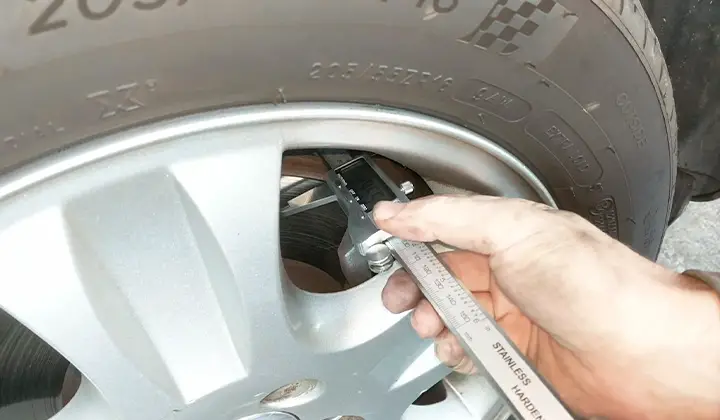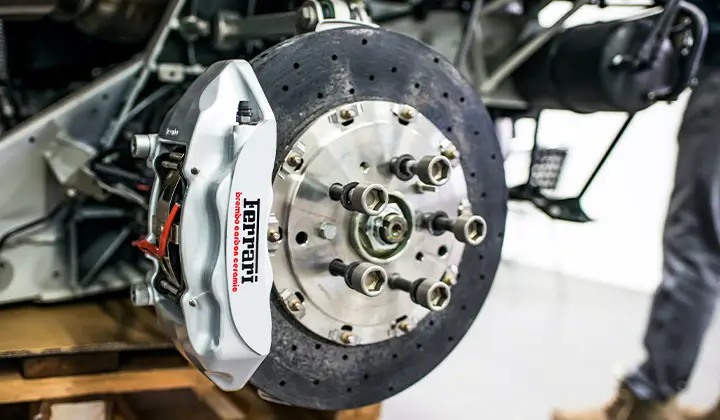Hot spots on rotor blades are a common problem that causes decreased fuel efficiency and higher emissions in engines.
The cause of the hot spot is often due to corrosion or oxidation on the blade surface, which can lead to increased friction and heat.
Prevention is the best policy for dealing with this issue, as finding and repairing the source early will save you money in downtime and repairs later on.
If you see hot spots on your car’s rotors, it could be a sign that the brakes are in need of replacement. Hot spots on rotor surfaces indicate that there is excessive friction between the rotor and the brake pad or shoe.
This can cause wear and tear on the braking system, which may then necessitate a new set of brakes.
Some of the causes could include worn or defective rotors, varnish buildup, and brake dust.
Each of these factors will cause a hot spot on the rotor, which in turn will lead to reduced braking performance.
Contents
- 1 What Causes Hot Spots on Rotors
- 2 Signs of Hot Spots on Rotors
- 3 FAQs
- 3.1 Can You Turn Rotors with Hotspots?
- 3.2 What Causes Rotors to Burn?
- 3.3 Can You Pour Water on Hot Brakes?
- 3.4 Do Overheated Brakes Need to Be Replaced?
- 3.5 Why Does It Smell Like My Brakes Are Burning?
- 3.6 What Is Typical Brake Rotor Temperature?
- 3.7 Can Brakes Catch Fire?
- 3.8 Should My Brake Rotors Be Hot?
- 3.9 Can a Stuck Caliper Cause a Fire?
- 3.10 How To Stop Rotors from Rusting?
- 4 Conclusion
What Causes Hot Spots on Rotors
If you notice hot spots on your car’s rotor, it is likely due to a problem with the braking system. The brake pads are made of metal and rubber, and when they make contact with the rotor, heat is generated.
This can cause the pad to expand too much and create a hot spot on the rotor.
Coolant System Fluid Leaks
One of the most common causes of hot spots on rotors is a leak in the coolant system.
When this happens, the boiling heat from the engine will cause the metal to expand and form areas of localized distortion on the rotor surface.
Overheating Rotor Material
If your vehicle’s brake pads are not properly gripping the rotor, it can result in excessive heat being applied to it which can cause hotspots or cracking on your rotor.
This type of damage is often caused by poorly performing brake pads or worn-out rotors that have been subjected to too much stress over time.
Worn Brake Pads and Calipers
Worn brakes can also lead to overheating and eventual disc failure due to corrosion issues with brake pad material and caliper pistons. In extreme cases, this may even result in a blown head GAP (the gap between pad & rotor.

Faulty Master Cylinder Assembly
A faulty master cylinder assembly can also be a source of hot spots on your rotors because it doesn’t deliver enough pressure when you need it most – during hard braking or while driving at high speeds downhill.
Faulty brake pads or rotors
A failing brake pad or rotor can cause hot spots on the rotor surface. This is because the friction between the pad and rotor causes heat to build up, which in turn can damage the rotor.

Poor wear and tear on brakes
Brake pads and rotors should be replaced after a set period of time (typically 10,000 miles), but if they are not used properly, they may not last as long as they should. Brake dust accumulation also plays a role in causing hot spots on rotors.
Damaged calipers or brackets
If your car has damaged calipers or brackets, this will affect how well your brakes work and could lead to hot spots on your rotor surface.
Lowered tire pressure
When you drive with low tire pressure, it increases drag on your vehicle’s braking system due to air resistance forces acting against the car’s motion – this is why you might see increased braking distances when driving at lower altitudes or under reduced air pressure conditions such as during rainstorms or snowstorms.
Signs of Hot Spots on Rotors
If you see hot spots on your rotor, it could mean there is a problem with the cooling system. The rotors are cooled by a liquid that circulates through them and passes over the heat source.
If this liquid isn’t flowing properly or if the temperature gets too high, hotspots may form on the surface of the rotor.
Noticeable Cracks
If you see noticeable cracks on your rotor, it’s time to take action. Rotors are responsible for keeping your car safe by providing a smooth surface so that the vehicle can move properly.
If there are too many cracks, this can cause your rotor to become distorted and eventually fail.
Grooves
When the rotors run over debris or any other object, they will create grooves in them as they go by. Over time, these grooves may grow bigger and lead to heat spots on the rotor which will damage it further.
Rotor Edge Lip
The edge of a rotor is very important because it helps keep the car moving in a straight line while driving at high speeds or during sudden turns.
If there is an issue with this part of the rotor, it could result in warped rotors which would then be susceptible to heat spots and cracks later on down the road.
Heat Spots
Rotors get hot when they’re working hard – specifically when you hit a bumpy road or try to accelerate quickly from a stoplight.
This intense friction causes metal to heat up quickly and creates hotspots on the surface of your rotor blade which can ultimately lead to its deterioration.
Distorted Rotors
A warped or damaged rotor doesn’t just look terrible – it also reduces how much power your engine can generate, making your ride significantly worse than usual.
FAQs
Can You Turn Rotors with Hotspots?
Yes, you can turn rotors with hotspots. This is a relatively easy process, but it requires some effort.
What Causes Rotors to Burn?
The main cause of burning rotors is a lack of lubrication, but this can also be caused by temperature and dust particles.
Can You Pour Water on Hot Brakes?
While it is true that you cannot pour water on a hot brake, you can definitely pour it over a cold brake.
The temperature of the brake fluid in the system will have an effect on the temperature of the wet brakes.
Do Overheated Brakes Need to Be Replaced?
The answer is yes. Studies show that the brakes can be replaced at a cost of about $1,000 per vehicle. It is a common misconception that the brake pads will wear out and need to be replaced at a certain point in time.
Why Does It Smell Like My Brakes Are Burning?
The smell of burning brakes is usually caused by brake fluid leaking onto the hot brake calipers. This fluid can then evaporate and leave behind a strong, unpleasant smell.
What Is Typical Brake Rotor Temperature?
The temperature of a brake rotor should be between 200 degrees Fahrenheit and 600 degrees Fahrenheit during normal driving conditions.
Can Brakes Catch Fire?
Brakes catch fire when this heat builds up too much or if there is an electrical short-circuit that causes sparks or flames from the system, which can
Should My Brake Rotors Be Hot?
It is generally recommended that brake rotors should be cool to the touch. If they are excessively hot, the brake pads may not have a good surface to adhere to, slowing down the car.
Can a Stuck Caliper Cause a Fire?
A stuck caliper is a condition that occurs when the brake pads on a bicycle are not released from the rim. It can cause a fire if it is not resolved quickly.
How To Stop Rotors from Rusting?
To prevent the rotors from rusting, you can either use a wire brush to clean them or apply a thin layer of oil.
Rust is mostly caused by oxidation. This happens when the iron in the metal reacts with oxygen in the air and water.
The best way to prevent this from happening is to keep your bike’s rotors dry and clean them regularly.
Conclusion
If you see hot spots on your car’s rotor, it may be a sign that there is something wrong with the rotors.
These are the spinning disks at the front of your car that help stop it from skidding and provide traction.
If they’re damaged or worn out, they can create heat and cause problems such as brake failure.
Hot spots on the rotor can be caused by a number of things, but the most common is wear and tear. The metal that makes up the rotor becomes very hot as it rotates, and this can cause heavy deposits to form.
Over time these deposits can reduce friction between the disk and wheel which will cause them to heat up even more.
